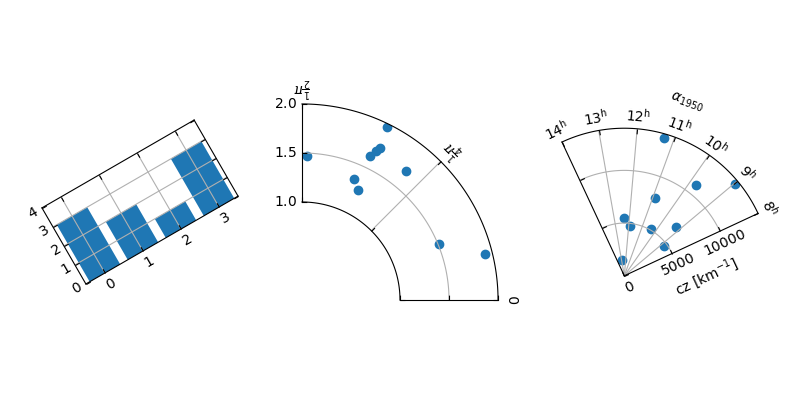Observação
Clique aqui para baixar o código de exemplo completo
mpl_toolkits.axisartist.floating_axesrecursos #
Demonstração das funcionalidades do floating_axesmódulo:
Use
GridHelperCurveLinearpara girar o gráfico e definir o limite do gráfico.Usando
FloatingSubplotpara criar uma subtrama usando o valor de retorno deGridHelperCurveLinear.Fazendo um gráfico de setor adicionando mais recursos ao arquivo
GridHelperCurveLinear.
from matplotlib.transforms import Affine2D
import mpl_toolkits.axisartist.floating_axes as floating_axes
import numpy as np
import mpl_toolkits.axisartist.angle_helper as angle_helper
from matplotlib.projections import PolarAxes
from mpl_toolkits.axisartist.grid_finder import (FixedLocator, MaxNLocator,
DictFormatter)
import matplotlib.pyplot as plt
# Fixing random state for reproducibility
np.random.seed(19680801)
def setup_axes1(fig, rect):
"""
A simple one.
"""
tr = Affine2D().scale(2, 1).rotate_deg(30)
grid_helper = floating_axes.GridHelperCurveLinear(
tr, extremes=(-0.5, 3.5, 0, 4),
grid_locator1=MaxNLocator(nbins=4),
grid_locator2=MaxNLocator(nbins=4))
ax1 = fig.add_subplot(
rect, axes_class=floating_axes.FloatingAxes, grid_helper=grid_helper)
ax1.grid()
aux_ax = ax1.get_aux_axes(tr)
return ax1, aux_ax
def setup_axes2(fig, rect):
"""
With custom locator and formatter.
Note that the extreme values are swapped.
"""
tr = PolarAxes.PolarTransform()
pi = np.pi
angle_ticks = [(0, r"$0$"),
(.25*pi, r"$\frac{1}{4}\pi$"),
(.5*pi, r"$\frac{1}{2}\pi$")]
grid_locator1 = FixedLocator([v for v, s in angle_ticks])
tick_formatter1 = DictFormatter(dict(angle_ticks))
grid_locator2 = MaxNLocator(2)
grid_helper = floating_axes.GridHelperCurveLinear(
tr, extremes=(.5*pi, 0, 2, 1),
grid_locator1=grid_locator1,
grid_locator2=grid_locator2,
tick_formatter1=tick_formatter1,
tick_formatter2=None)
ax1 = fig.add_subplot(
rect, axes_class=floating_axes.FloatingAxes, grid_helper=grid_helper)
ax1.grid()
# create a parasite axes whose transData in RA, cz
aux_ax = ax1.get_aux_axes(tr)
aux_ax.patch = ax1.patch # for aux_ax to have a clip path as in ax
ax1.patch.zorder = 0.9 # but this has a side effect that the patch is
# drawn twice, and possibly over some other
# artists. So, we decrease the zorder a bit to
# prevent this.
return ax1, aux_ax
def setup_axes3(fig, rect):
"""
Sometimes, things like axis_direction need to be adjusted.
"""
# rotate a bit for better orientation
tr_rotate = Affine2D().translate(-95, 0)
# scale degree to radians
tr_scale = Affine2D().scale(np.pi/180., 1.)
tr = tr_rotate + tr_scale + PolarAxes.PolarTransform()
grid_locator1 = angle_helper.LocatorHMS(4)
tick_formatter1 = angle_helper.FormatterHMS()
grid_locator2 = MaxNLocator(3)
# Specify theta limits in degrees
ra0, ra1 = 8.*15, 14.*15
# Specify radial limits
cz0, cz1 = 0, 14000
grid_helper = floating_axes.GridHelperCurveLinear(
tr, extremes=(ra0, ra1, cz0, cz1),
grid_locator1=grid_locator1,
grid_locator2=grid_locator2,
tick_formatter1=tick_formatter1,
tick_formatter2=None)
ax1 = fig.add_subplot(
rect, axes_class=floating_axes.FloatingAxes, grid_helper=grid_helper)
# adjust axis
ax1.axis["left"].set_axis_direction("bottom")
ax1.axis["right"].set_axis_direction("top")
ax1.axis["bottom"].set_visible(False)
ax1.axis["top"].set_axis_direction("bottom")
ax1.axis["top"].toggle(ticklabels=True, label=True)
ax1.axis["top"].major_ticklabels.set_axis_direction("top")
ax1.axis["top"].label.set_axis_direction("top")
ax1.axis["left"].label.set_text(r"cz [km$^{-1}$]")
ax1.axis["top"].label.set_text(r"$\alpha_{1950}$")
ax1.grid()
# create a parasite axes whose transData in RA, cz
aux_ax = ax1.get_aux_axes(tr)
aux_ax.patch = ax1.patch # for aux_ax to have a clip path as in ax
ax1.patch.zorder = 0.9 # but this has a side effect that the patch is
# drawn twice, and possibly over some other
# artists. So, we decrease the zorder a bit to
# prevent this.
return ax1, aux_ax
fig = plt.figure(figsize=(8, 4))
fig.subplots_adjust(wspace=0.3, left=0.05, right=0.95)
ax1, aux_ax1 = setup_axes1(fig, 131)
aux_ax1.bar([0, 1, 2, 3], [3, 2, 1, 3])
ax2, aux_ax2 = setup_axes2(fig, 132)
theta = np.random.rand(10)*.5*np.pi
radius = np.random.rand(10) + 1.
aux_ax2.scatter(theta, radius)
ax3, aux_ax3 = setup_axes3(fig, 133)
theta = (8 + np.random.rand(10)*(14 - 8))*15. # in degrees
radius = np.random.rand(10)*14000.
aux_ax3.scatter(theta, radius)
plt.show()
